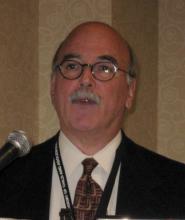NEW YORK – Adoption is founded on loss, and a child’s reaction to being adopted can often be best understood with a grief model.
The unresolved, uncommunicated, and unvalidated grief that some adopted children may feel often goes unrecognized as an overlay that accompanies more typical psychiatric disorders in adopted children, David Brodzinsky, Ph.D., said at the annual meeting of the American Academy of Child & Adolescent Psychiatry.
In other cases, adopted children may act up and present what looks like a serious psychiatric problem, but closer examination shows it is an adjustment reaction or other low-level problem that occurs as an adopted child struggles to understand the meaning and implications of adoption, said Dr. Brodzinsky, research and project director at the Evan B. Donaldson Adoption Institute in Oakland, Calif.
"I see two kinds of cases. In children with clinically relevant problems, such as depression, anxiety, or attention-deficit/hyperactivity disorder, the grief model is secondary to understanding and dealing with the psychopathology they have. But there is an overlay that often gets missed, a sense of loss that often is not treated because what you see is depression or anxiety and that has to be dealt with first. But we need to be sure not to miss the underlying sense of grief and loss. It’s not always present, but we need to look for it, and when it’s present, it needs to be dealt with," Dr. Brodzinsky said in an interview.
The second type of case involves children who have what might appear to be depression or anxiety but rather are symptoms that result exclusively from adoption-related grief that has not been appropriately validated.
However, the vast majority of adopted kids do not experience unvalidated grief and are "well within the normal range and do quite well," he said. "Adopted individuals are highly variable in the way they experience adoption-related loss."
If a sense of loss occurs among children who were adopted as infants, it usually appears before age 5-7 years. Children can begin to have a feeling of separation from someone about whom they don’t know much, which can lead to anxiety, sadness, and anger. In some children, "the experience of loss may be quite subtle and not easily observed by others."
Children who were adopted at an older age are more likely to have a more traumatic reaction, but again their understanding of adoption and their reaction to it varies over time as they age. "As children begin to understand the implications of their adoptive status, they become increasingly sensitized to adoption-related loss," Dr. Brodzinsky said.
The sense of loss that some adopted children develop can stem from several different factors and realizations, including loss of birth parents and loss of their entire birth family; loss of their biological, ethnic, racial, and cultural origins; loss of prior nonbiological caregivers; loss of status among their peers; loss of their emotional stability; loss of their feeling of fitting in with their adoptive family; loss of privacy; and loss of their self-identify.
Perhaps the most important consequence of an emerging sense of loss occurs when it leads to disenfranchised grief: The loss goes unrecognized by others or is minimized or trivialized. "Too often, the focus in adoption is on what the child gained" without an acknowledgement of what was lost, he said. "Too often adoptees and birth parents have not had their sense of loss validated by people around them."
Adopted children face the risk that their blocked, disenfranchised grief could become clinical depression. Viewing the loss in a grief model normalizes the child’s reactions rather than casting them as pathological.
Four interventions have shown efficacy for resolving grief and a sense of loss in adopted children. Two approaches especially suited to younger children are "life books" and bibliotherapy. Therapeutic rituals can potentially help at any age. Written role play is a good intervention for older teens and adults.
Many therapists use life books for interventions. Dr. Brodzinsky prefers books created by the patient, often as loose-leaf pages in a binder, rather than commercially available versions. The book is like a photo album of the child’s past, but can also contain drawings and text. The child constructs the book, which helps bring order to what can feel like an otherwise chaotic life story, giving the child a sense of where she comes from and where she is going. What goes into the book depends on the child’s age, willingness to deal with various adoption issues, and the information available. When used in treatment, the child and therapist review the contents of the book repeatedly, as well as adding to it when appropriate. Use of a book opens communication, gives the child a more realistic understanding of his adoption, and gives the child a more positive view of self. Life books usually work best for those aged 4 years to about 11, Dr. Brodzinsky said.

